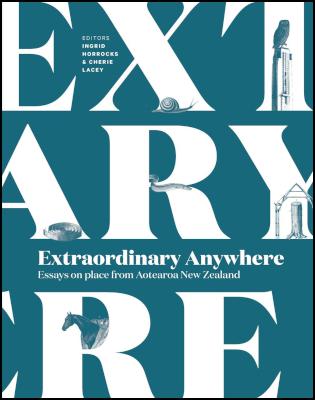Extraordinary Anywhere: Essays on Place from Aotearoa New Zealand
Edited by Ingrid Horrocks and Cherie Lacey (Victoria U Press, $40)
Reviewed by Max Rashbrooke
First published in Scoop Review of Books

When I was coming to the end of my six-year stint in London, British people would often say to me, ‘I quite understand why you’d go back to New Zealand – I mean, the landscape, it’s so beautiful, why wouldn’t you?’ Because they were often just making polite conversation, I didn’t bother correcting them, but in fact that was hardly the reason I was returning.
The New Zealand landscape undoubtedly is very beautiful, but so is the British one, and my attachment to this country is much more about some particular places, and the memories and emotions that in them combine, than it is about the landscape as a whole.
So I welcome the decision by Ingrid Horrocks and Cherie Lacey, the editors of Extraordinary Anywhere, to focus their collection of place-based essays on “the obsession, fascination, wonder and often intense unease experienced in relation to particular spots in this country … how lives are actually lived in very specific places, and how these lives – and places – have changed over time”. This gets us away from that banal discussion about the New Zealand landscape and ‘what it means to us’, a discussion that has long since ceased to be interesting, if ever it was. I also welcome the fact that the essays, as you’d expect in this day and age, largely reject the idea of a fixed landscape: they are alive to the way that places are constructed in our imagination, the way that they are constantly coming into being, creating their meaning by acting as the nodes of all kinds of movements, relationships, connections.
Some of the book’s strongest essays are in the first section, ‘Any place might be extraordinary if only we knew it’. Ashleigh Young’s essay ‘The Te Kuiti Underground’ is a meditation, both sad and funny, about the way that the desire to escape a small town can live alongside a fierce pride in, and knowledge of, that place, while Tony Ballantyne turns his decades-long familiarity with a South Dunedin chip shop into a lens on the economic collapse of its surrounding suburbs.
Among the others, I particularly enjoyed Lydia Wevers’s essay ‘Dirt’, about the extraordinary library established in the 1880s for the farm workers on Brancepeth, one of the great Wairarapa homesteads. In her hands, the extreme dirtiness of the books as they now exist, covered in “wax dribbles, glass rings, food crusts and oily fingerprints”, becomes the “contact zone” between the present writer and these past readers, conjuring up, through the contrast with the tooled-leather books of the ruling family’s library, the strict class stratification of nineteenth-century farm life.
Powerful, too, is Lacey’s ‘Underwater Reach’, in which the bringing-up of land by the 1931 Napier earthquake runs parallel to a painful description of the psychoanalytic process. Thinking about the way her family relates to this ‘new’ land allows Lacey to find, in the face of the onslaught that psychoanalytic training waged against her identity, “a text for which it is possible for me to be the author, since this is a place that exists only for me, as me”.
The book’s third section, ‘The meshing of thought and world’, complicates things further by looking at abstract, semi-real, and artificial spaces. Ian Wedde has a lot of fun with posters advertising “a real piece of Middle-earth” and the paradoxical status of the “location” of said Middle-earth at Matamata, while Giovanni Tiso reflects on the unsettling experience of Google creating photo albums out of his own holiday snaps, an incident that becomes the launchpad for a call to find ways of writing that “go against the grain [and] resist being reduced to a statistical norm”, since it is from that resistance that “we can find insight and learn to say that which is not obvious, and that a machine couldn’t guess”.
The book’s second section, ‘You take place with you as you go on’, is perhaps the least successful. Several writers seem to have ambitions they can’t quite fulfil in a few thousand words. Alice Te Punga Somerville poses hugely relevant questions – can place re-place a writer? How do Maori write in place? Who writes in place of Maori? – without being able to answer them fully, although she does make the important point that Maori writers still appear to be severely underrepresented in courses on New Zealand literature.
Harry Ricketts posits the interesting idea that for people without a fixed place of belonging, the past becomes a set of “imaginary homelands”, but again he isn’t able to substantiate the thought. Annabel Cooper’s essay is simply too scattered to have much force, while the point of Jack Ross’s piece on Erewhon is hard to discern. In contrast, there is a very strong and moving essay by Tina Makereti, who talks about the problems of identity for those who have Maori ancestry and therefore are supposed to have a strong sense of where they are ‘from’, but whose upbringing has not in fact equipped them with one. Even if you are technically welcome on a number of marae, she asks, if you aren’t contributing to and constantly renewing your connection to them, what does that ‘welcome’ or ‘belonging’ actually mean?
Apart from the essays by Makereti and Te Puinga Somerville, there are relatively few Maori voices in this collection, considering the great importance, as I understand it, of whenua (land), to Maori identity. The collection also reveals the shallowness of much Pakeha engagement with those issues. Is there such a thing as the Pakeha turangawaewae, a notion that one of the essayists, Alex Calder, has investigated elsewhere? How do Pakeha talk about belonging to specific spaces without appropriating or trampling on indigeneity?
There are so many of these questions that could be discussed in this collection, but mostly aren’t. Ricketts’s essay, for instance, begins – not unreasonably – with a mihi, but as Martin Edmonds points out in his closing essay, such Pakeha efforts “inevitably lack conviction”; and there is, as I understand it, a debate among Maori language teachers about whether, in their mihi, Pakeha should stop trying to name awa and maunga (rivers and mountains) when those landmarks are often not very important to them, and instead find landscape features that they actually feel are meaningful – a move that, though diverging from Maori practice, might in fact pay it more respect by acknowledging its real import.
Another absence, for me, was any sense of rootedness. None of the authors is writing out of a warm, continuous, ongoing connection with place. Instead their relationships are temporary, shifting, of the past but not the present, or vice-versa. Undoubtedly there are good reasons for this. New Zealanders are hyper-mobile people, moving house twice as often as, for instance, the typical British person. (And often for bad reasons: many of these moves are made in the attempt to find housing that is not cold, damp and dangerous to health.)
But there are forms of permanent relationship with the land, and not only for Maori. I myself grew up in what sociologists would call a community of memory, an enclave of long-standing family houses in which relatives were constantly reciting stories that pulled us back into the past but also, by positing those stories as models of behaviour, pushed us into the future. This childhood, saturated by memory and surrounded by relatives, took place in a community that intermingled lineal histories and place in extraordinarily deep and rich ways.
I don’t think that this was a typical Pakeha upbringing; in fact I’m sure it wasn’t. But nor was it unique. And I do think that, even in an age where we rightly look to narratives that shift and unsettle, we also need to be able to talk – lyrically, even – about permanence, iteration, an unbroken series of moments in one place. That too is an important species of space.



 Keith Rankin: Judaism, Antisemitism, And Israel
Keith Rankin: Judaism, Antisemitism, And Israel Ian Powell: Haka, Hikoi And The Empowerment Of The Kohanga Generation
Ian Powell: Haka, Hikoi And The Empowerment Of The Kohanga Generation Binoy Kampmark: Feeding Chaos - Israel Cripples Syria’s Defence
Binoy Kampmark: Feeding Chaos - Israel Cripples Syria’s Defence The Conversation: News Bargaining Incentive:
The Conversation: News Bargaining Incentive: Binoy Kampmark: Last Acts -Time For Biden To Pardon Assange
Binoy Kampmark: Last Acts -Time For Biden To Pardon Assange Binoy Kampmark: Foiling Rupert Murdoch - Project Harmony Misfires
Binoy Kampmark: Foiling Rupert Murdoch - Project Harmony Misfires